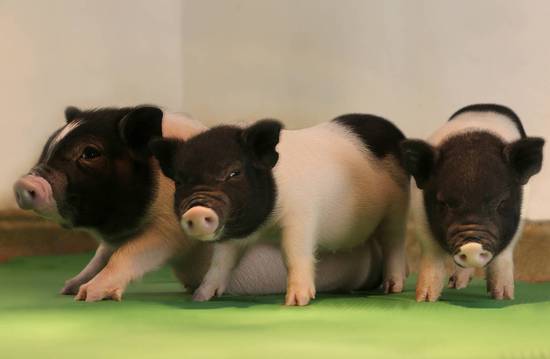Products | NetEase Scientific People Section
Translator | Lebang

New study inactive retrovirus (PERV) newborn pigs
In a new study that embodies the rapid development of genetic science, researchers use the Crispr gene editing system to transform animals. This may help advance the scientific research of the transplantation of animal organs into the human body.
In one study, scientists created piglets that no longer have active viral genes. This is an important step in making their organs suitable for transplantation into the human body. The piglets, who are the oldest, have been four months old and will also allow researchers to study the long-term effects of genetic editing on a human-like organism.
In addition, two research teams changed the genes of ants to change their social behavior. This will help study human disorders. Like humans, ants exhibit complex social behavior.
Shelley Berger of the Perelman School of Medicine at the University of Pennsylvania said: "Now, all biological research is no longer just covering a few organisms. With Crispr, any organism can be used. To study the basic questions of biology.†Berger is a member of the team that applies Crispr technology to Indian ants.
The Crispr Chinese full name is a short-spaced, palindromic repeat sequence of regular clusters that evolved over millions of years as a bacterial immune system. Scientists use it to create a target gene that can excise, modify, or modify disease-causing mutations in the genomes of animals and humans. The Crispr-Cas9 system has great potential to bring therapeutic solutions to various diseases in humans and is currently being used for the study of cancer, muscular dystrophy, and many other conditions.

Workers are coloured to facilitate their tracking of personal behavior
However, this technology has also raised some important ethical issues, especially considering that genetic editing will bring changes to human germline, sperm genes, eggs or embryos.
This change will not only change individuals, but also inherit to future generations.
People’s eyes are largely focused on the risks and possibilities associated with the funding of human germline editors, but current research has found that Crispr also has a great influence on changing the genetics of animals.
“Crispr can be used to guide the evolution of other species,†said Eleonore Pauwels of the Wilson Center in Washington, DC. “What we do in other species also relates to how we should Develop responsible technology."
In a study on pigs published in Science, a research team including the founder of eGenesis used Crispr to inactivate all 62 retroviruses (PERVs) in pig cells.
Those retroviruses are dormant in pigs, but concerns about the spread of the virus to humans are a major obstacle to advancing xenotransplantation. The scientists used Crispr to genetically engineer swine cells to create embryos that were implanted in surrogate sows. Surrogate sows produced 37 inactive retrovirus piglets. According to research papers, 15 are still alive.
The author of the paper, Lugene Yang, co-founder and chief scientific officer of eGenesis, said that the study could solve a key security concern. However, she added, additional modifications are needed to ensure that organ transplantation does not trigger the human immune system to reject pig organs.
Her eGenesis company is seeking to use gene editing techniques to facilitate xenotransplantation.
The ant study published in Cell magazine used Crispr technology on ant eggs to make genetic changes in each of the adult ants in the ant population studied.
Researchers at Rockefeller University in New York used Crispr to transform the olfactory genes of ant named orco. In another study, a team of researchers from New York University, NYU Longignee Medical School, Arizona State University, Vanderbilt University, and the University of Pennsylvania eliminated the same genes except that they were in India. Jumping ants carry it out.
The researchers found that once orco olfactory genes were removed, ants were no longer able to sense or respond to important chemical cues. They walked aimlessly outside the nest and did not collect food. According to Daniel Kronauer, an assistant professor at Rockefeller University and the lead author of the Indian ant research paper, these ants provide a potential model for studying human disorders involving complex social behaviors, such as autism.
With Crispr, researchers can now conduct more research around ants. Ants have long been fascinated by researchers, but they are difficult to cultivate in the laboratory.
Dr. Berger of the University of Pennsylvania said, "A bit of a transformation, the ant is not the original ant." (Lebang)
ZGAR Aurora 500 Puffs
ZGAR electronic cigarette uses high-tech R&D, food grade disposable pod device and high-quality raw material. All package designs are Original IP. Our designer team is from Hong Kong. We have very high requirements for product quality, flavors taste and packaging design. The E-liquid is imported, materials are food grade, and assembly plant is medical-grade dust-free workshops.
Our products include disposable e-cigarettes, rechargeable e-cigarettes, rechargreable disposable vape pen, and various of flavors of cigarette cartridges. From 600puffs to 5000puffs, ZGAR bar Disposable offer high-tech R&D, E-cigarette improves battery capacity, We offer various of flavors and support customization. And printing designs can be customized. We have our own professional team and competitive quotations for any OEM or ODM works.
We supply OEM rechargeable disposable vape pen,OEM disposable electronic cigarette,ODM disposable vape pen,ODM disposable electronic cigarette,OEM/ODM vape pen e-cigarette,OEM/ODM atomizer device.

Aurora 500 Puffs,Pod System Vape,Pos Systems Touch Screen,Empty Disposable Vape Pod System,500Puffs Pod Vape System
ZGAR INTERNATIONAL TRADING CO., LTD. , https://www.szvape-pen.com